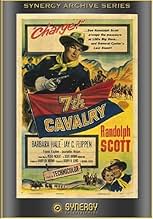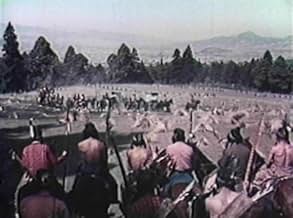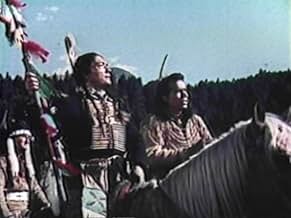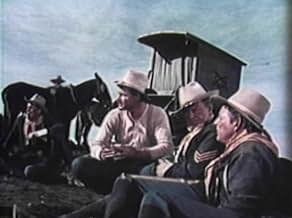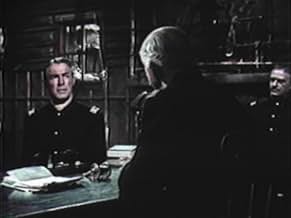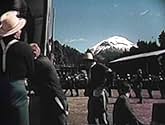CALIFICACIÓN DE IMDb
5.8/10
1.5 k
TU CALIFICACIÓN
Un oficial acusado de cobardía se ofrece voluntario para recuperar el cuerpo del General Custer después de Little Big Horn.Un oficial acusado de cobardía se ofrece voluntario para recuperar el cuerpo del General Custer después de Little Big Horn.Un oficial acusado de cobardía se ofrece voluntario para recuperar el cuerpo del General Custer después de Little Big Horn.
- Dirección
- Guionistas
- Elenco
Bill Clark
- Soldier With Kellogg
- (sin créditos)
Charles Horvath
- Knife-Wielding Indian
- (sin créditos)
William Leslie
- Lt. Murray
- (sin créditos)
Harold Miller
- Officer at Inquiry
- (sin créditos)
- Dirección
- Guionistas
- Todo el elenco y el equipo
- Producción, taquilla y más en IMDbPro
Opiniones destacadas
At 58, Scott was just too old for the role. Not just being only a Captain, but still in cavalry. Not realistic he would have physicality for the activity his character displays.
Set after the Battle Of Little Big Horn, 7th Cavalry sees Randolph Scott playing Captain Benson, who returns with his future bride to his post commanded by Indian fighter, Colonel Custer. Custer however was gone, he had taken the famous 7th Cavalry to war with the Sioux at Big Horn and lost badly. Guilt ridden and tarnished by whispers of cowardice, Benson volunteers to lead a dangerous mission back to Big Horn to reclaim the bodies of the fallen soldiers.
There doesn't appear to be much much love for this 1956 Columbia Pictures Oater. Seems it's either damned for being too talky, or on the flip side, it's too hokey within its plotting to actually merit worth. Well that's a shame for this has something of a vintage feel to it, the themes of guilt and redemption are Western standards, whilst the story also takes in interesting arcs such as religious beliefs and spiritual meanings. Yes this is definitely a "talky" picture - aside from some mano mano action and single horse pursuits that is - but it's a well thought out screenplay by Peter Packer (adapting from Glendon Swarthout's story). Instances such as a military enquiry and an exchange between Benson and a young Indian warrior are intelligent passages in the story (with Scott doing fine work in the process). What it lacks in gusto action it more than makes up for with the characterisations.
Other plus points are that it's also nicely shot in Mexico, the Technicolor doing justice to the splendid costumes on show. Backing Scott up in support are admirable performers such as Jay C. Flippen, Frank Faylen, Leo Gordon, Michael Pate and Harry Carey Junior. Although the ladies (Jeanette Nolan & Barbara Hale) aren't given too much to do and the score conducted by Mischa Bakaleinikoff is at odds with the tempo of the film, 7th Cavalry still deserves a better reputation than it currently has. If you prepare for a work of fiction that is most assuredly dialogue driven, then hopefully your expectations will at the least be met. 7/10
There doesn't appear to be much much love for this 1956 Columbia Pictures Oater. Seems it's either damned for being too talky, or on the flip side, it's too hokey within its plotting to actually merit worth. Well that's a shame for this has something of a vintage feel to it, the themes of guilt and redemption are Western standards, whilst the story also takes in interesting arcs such as religious beliefs and spiritual meanings. Yes this is definitely a "talky" picture - aside from some mano mano action and single horse pursuits that is - but it's a well thought out screenplay by Peter Packer (adapting from Glendon Swarthout's story). Instances such as a military enquiry and an exchange between Benson and a young Indian warrior are intelligent passages in the story (with Scott doing fine work in the process). What it lacks in gusto action it more than makes up for with the characterisations.
Other plus points are that it's also nicely shot in Mexico, the Technicolor doing justice to the splendid costumes on show. Backing Scott up in support are admirable performers such as Jay C. Flippen, Frank Faylen, Leo Gordon, Michael Pate and Harry Carey Junior. Although the ladies (Jeanette Nolan & Barbara Hale) aren't given too much to do and the score conducted by Mischa Bakaleinikoff is at odds with the tempo of the film, 7th Cavalry still deserves a better reputation than it currently has. If you prepare for a work of fiction that is most assuredly dialogue driven, then hopefully your expectations will at the least be met. 7/10
While George Armstrong Custer was getting massacred at Little Big Horn, Captain Randolph Scott was off wooing and fetching fiancée Barbara Hale, with Custer's permission he says. He escapes court martial, but no one wants anything to do with him. So when it's decided that someone needs to fetch Custer's corpse back - never mind the enlisted men - Scott volunteers to lead the expedition.
It's one of the superb westerns that Scott starred in during the last fifteen years of his movie career, and Joseph H. Lewis directs this with his immensely strong visual style, Technicolor specialist Ray Rennahan shooting from low angles in an ochre-based color matrix. Lots of Strong Men behaving nobly...but is the Comanche idea of nobility the same as the White man's? With Jay C. Flippen, Harry Carey Jr. and Frank Faylen.
It's one of the superb westerns that Scott starred in during the last fifteen years of his movie career, and Joseph H. Lewis directs this with his immensely strong visual style, Technicolor specialist Ray Rennahan shooting from low angles in an ochre-based color matrix. Lots of Strong Men behaving nobly...but is the Comanche idea of nobility the same as the White man's? With Jay C. Flippen, Harry Carey Jr. and Frank Faylen.
Returning to Fort Lincoln, Captain Benson (Randolph Scott) learns of Custer's defeat at the Little Big Horn. Meanwhile, Benson carries his girlfriend ,Martha Kellogg (Barbara Hale), to the fort commanded by Col. Kellogg (Russell Hicks) who's Martha's father. Benson who was branded a coward for not taking part in the festivities attempts to assuage his guilt by heading up the burial detail, along with a group drunks and misfits (Leo Gordon, Denver Pyle, Harry Carey Jr, Frank Faylen) . At the inquiry as Custer's Officers blame Custer for the defeat, Benson tries to defend him. But Benson was suspiciously absent at the time of the battle and is now despised by the troops. So when an order to retrieve the bodies from the battlefield arrives, Benson volunteers for the dangerous mission of returning back into Indian territory. Charging the battle lines of the Sioux and the Cheyennes !. "Charge!"...See Randolph Scott avenge the massacre at Little Big Horn...and General Custer's Last Stand!
The film depicts a somewhat different look at Custer's defeat at the Little Big Horn, here an officer accused of cowardice volunteers to bring back General Custers's body after Little Big Horn. The muddled ending tries to tell us that the Indians were afraid of Custer's horse. One of Joseph H Lewis' two colour movies, a weird and occasionally enjoyable little Western focusing on the enmity between white and red man as Scott, accused of deserting Custer out of cowardice during the fiasco of Little Big Horn, sets out to discover the truth of the massacre. The film is acceptable and decent enough, being beautifully filmed and briskly paced. It's most interesting for a surprising anti-Custer stance, and for its surreal, almost supernatural event, which sees Custer's horse showing up like a ghost from the wilderness to allegedly bring peace between enemies. Stars Randolph Scott who gives a nice acting in his usual style as a cavalry officer accused of cowardice and is placed in charge of rebel soldiers detailed to bury the dead after the onslaught. In 7th Cavalry (1956) stands out a splendid plethora of secondaries at the time, such as: Jay C. Flippen, Frank Faylen, Jeanette Nolan, Leo Gordon, Denver Pyle, Harry Carey Jr. , Michael Pate, Pat Hogan, Russell Hicks, Frank Wilcox, Donald Curtis and Frank Hogan.
This Western is just a shade different thanks to Peter Parker's script and especially to the shooting of Joseph H Lewis, though nothing special. Professionally directed by Joseph H Lewis who chooses all the right angles for a real impact and never puts a wrong foot. He never really rose above the second feature, but turned in some fine work within the genre. During two decades, Lewis spent time at Columbia (1939-40, 1946-49), Universal again (1942), PRC (1944), MGM (1950, 1952-53) and United Artists (1957-58), reliably turning out a couple of pictures per year. While he helmed more than his fair share of horse operas, it was invariably his films noir which attracted the most attention. Lewis was a B craftsman who directed a lot of films of all kinds of genres with a penchant for Noir movies, as he made Drama, Thriller, Action, Western such as Terror in a Texas town, 7th cavalry, The Halliday brand, A lawless street, Cry of the hunted, Retreat hell, Desperate search , A lady without passport, The undercover man, So dark the night, My name is Julia Ross, The mad doctor of Market Street, The gang of mine and his greatest hits were The Big Combo and Gun Crazy . He spent a few more years directing episodic TV westerns (including several of the better episodes of The Rifleman (1958) and finally retired in 1966. Rating 6/10. Essential and indispensable watching for Western enthusiasts and Randolph Scott fans.
The film depicts a somewhat different look at Custer's defeat at the Little Big Horn, here an officer accused of cowardice volunteers to bring back General Custers's body after Little Big Horn. The muddled ending tries to tell us that the Indians were afraid of Custer's horse. One of Joseph H Lewis' two colour movies, a weird and occasionally enjoyable little Western focusing on the enmity between white and red man as Scott, accused of deserting Custer out of cowardice during the fiasco of Little Big Horn, sets out to discover the truth of the massacre. The film is acceptable and decent enough, being beautifully filmed and briskly paced. It's most interesting for a surprising anti-Custer stance, and for its surreal, almost supernatural event, which sees Custer's horse showing up like a ghost from the wilderness to allegedly bring peace between enemies. Stars Randolph Scott who gives a nice acting in his usual style as a cavalry officer accused of cowardice and is placed in charge of rebel soldiers detailed to bury the dead after the onslaught. In 7th Cavalry (1956) stands out a splendid plethora of secondaries at the time, such as: Jay C. Flippen, Frank Faylen, Jeanette Nolan, Leo Gordon, Denver Pyle, Harry Carey Jr. , Michael Pate, Pat Hogan, Russell Hicks, Frank Wilcox, Donald Curtis and Frank Hogan.
This Western is just a shade different thanks to Peter Parker's script and especially to the shooting of Joseph H Lewis, though nothing special. Professionally directed by Joseph H Lewis who chooses all the right angles for a real impact and never puts a wrong foot. He never really rose above the second feature, but turned in some fine work within the genre. During two decades, Lewis spent time at Columbia (1939-40, 1946-49), Universal again (1942), PRC (1944), MGM (1950, 1952-53) and United Artists (1957-58), reliably turning out a couple of pictures per year. While he helmed more than his fair share of horse operas, it was invariably his films noir which attracted the most attention. Lewis was a B craftsman who directed a lot of films of all kinds of genres with a penchant for Noir movies, as he made Drama, Thriller, Action, Western such as Terror in a Texas town, 7th cavalry, The Halliday brand, A lawless street, Cry of the hunted, Retreat hell, Desperate search , A lady without passport, The undercover man, So dark the night, My name is Julia Ross, The mad doctor of Market Street, The gang of mine and his greatest hits were The Big Combo and Gun Crazy . He spent a few more years directing episodic TV westerns (including several of the better episodes of The Rifleman (1958) and finally retired in 1966. Rating 6/10. Essential and indispensable watching for Western enthusiasts and Randolph Scott fans.
This story revolves around an officer who is accused of cowardice after the battle of Little Big Horn but it's not really a case of an erstwhile hero trying to regain his honour in a dramatic and touching way as seen in a movie like SHANE and we don't get to see large scale battle scenes like in CUSTER OF THE WEST or THEY DIED WITH THEIR BOOTS ON . As it appears from reading through the comments on this page it seems the reviewers were expecting so much more from 7TH CALVARY as western fans . I guess not being a western fan I wasn't all that disappointed
There is a stand out moment which someone has picked up upon which is in relation to the battle itself and that is that the Americans were armed with single shot rifles while the Indian war party was armed with the Winchester repeating rifle . This is something that is often over looked by historians and film makers at the battle of Little Big Horn - The Indians were better armed since the American military thought a rifle that had a massive fire rate would use up far too much precious ammunition hence the blue coats didn't use the Winchester very often , contrary to what you see in paintings and films commemorating the battle
There is a stand out moment which someone has picked up upon which is in relation to the battle itself and that is that the Americans were armed with single shot rifles while the Indian war party was armed with the Winchester repeating rifle . This is something that is often over looked by historians and film makers at the battle of Little Big Horn - The Indians were better armed since the American military thought a rifle that had a massive fire rate would use up far too much precious ammunition hence the blue coats didn't use the Winchester very often , contrary to what you see in paintings and films commemorating the battle
¿Sabías que…?
- TriviaThe surname 'Kellogg' is used for two characters in the film - the colonel and his daughter Martha. It is also the surname of Mark Kellogg, a newspaper reporter who rode with Custer's troops. He was killed at the Battle of the Little Big Horn.
- ErroresAs Corporal Morrison (Harry Carey Jr.) saddles "Dandy", Lt. Col. Custer's second mount, he puts on an English saddle. US Calvary adopted McClellan saddles which remained in service through World War II. This was the wrong saddle for the movie.
- Citas
[first lines]
Capt. Tom Benson: We'll be able to see the fort from the top of the next rise.
[Tom and Martha ride a little farther]
Capt. Tom Benson: There she is - Fort Lincoln, the base of the finest cavalry regiment in the country - and our home.
- Créditos curiososOpening credits: Capt. Benson was returning with his future bride, to his post commanded by the gallant Indian fighter Colonel Custer, who had prepared the famous 7th for all out war with the Sioux.
Selecciones populares
Inicia sesión para calificar y agrega a la lista de videos para obtener recomendaciones personalizadas
- How long is 7th Cavalry?Con tecnología de Alexa
Detalles
- Fecha de lanzamiento
- País de origen
- Idioma
- También se conoce como
- El fantasma de la batalla
- Locaciones de filmación
- Productoras
- Ver más créditos de la compañía en IMDbPro
- Tiempo de ejecución1 hora 15 minutos
- Relación de aspecto
- 1.85 : 1
Contribuir a esta página
Sugiere una edición o agrega el contenido que falta

Principales brechas de datos
By what name was 7th Cavalry (1956) officially released in India in English?
Responda

